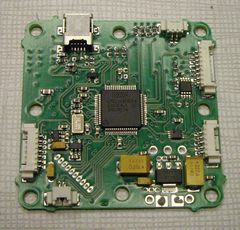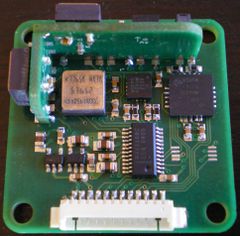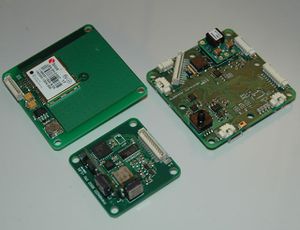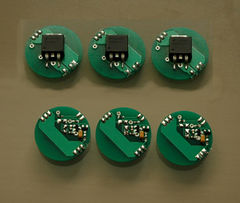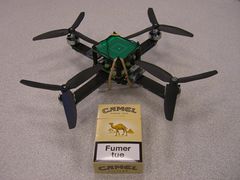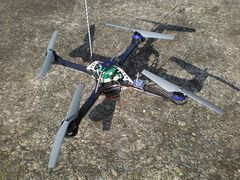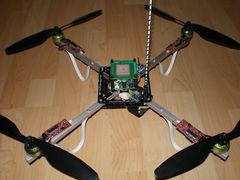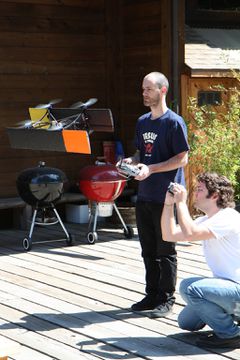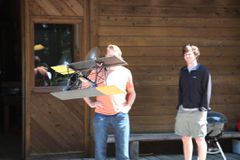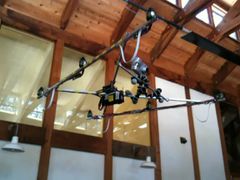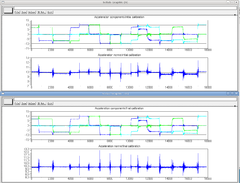Booz
Overview
Booz is an extension of Paparazzi to VTOLs. At the current stage of the project, the system provides attitude stabilization, vertical guidance and automatic navigation. It is able to use simple Paparazzi flight plans ( only go instructions ) and uses Paparazzi telemetry and datalink, which means all the Paparazzi ground segment applications are available( plotter, settings, gcs, etc...)
The current avionics consist in 3 boards
- The main board, comprising power supply, a LPC2148 and a barometer.
- The IMU board, comprising gyroscopes, accelerometers, magnetometers and a 16 bits ADC.
- The GPS board, using a LEA-5H by ublox.
Additional Booz boards:
- The "power" board.
It flies on a variety of Quad-rotor platforms
and less common vehicles
Program Sources
Everything is at savannah.
-hardware in paparazzi4/trunk/hw/booz -code in paparazzi3/trunk
Hardware
Motor controllers
Booz is able to handle a number of quadrotor specific brushless motor controllers.
more info in BoozMotorControllers
Power board
The power board allows to switch power on and off on your vehicle as well as to make a clean wiring by avoiding wired Y
more info in BoozPowerBoard
IMU
Booz has support for its custom designed IMU as well as for Cloudcap Crista IMU
more info in BoozIMU
Autopilot
Current version of Booz autopilot is based on a lpc2148
more info in BoozAutopilot
A new version of the autopilot, based on a STM32 is in development
more info in Lisa
Airframes
One nice thing about quadrotors is that the mechanics being extremely simple, they can be build with very little tools. Booz mounting holes are compatible with asctec and mikrokopter frames
more info in BoozAirframes
Purchasing Hardware
There are now vendors offering Booz hardware, Please see the Get Hardware page for details.
Running a simulator
Hardware Test
Booz comes with a number of simple test programs that you can use to validate a newly assembled board or learn how booz code works in case you want to extend it. The Makefile for those is in conf/autopilot/booz2_test_progs.makefile
test_downlink
Paparazzi's Makefile allow you to build different TARGETS (aka programs) using a doted notation. The begining of the Makefile reads
#
# test downlink
#
test_downlink.ARCHDIR = $(ARCHI)
test_downlink.ARCH = arm7tdmi
test_downlink.TARGET = test_downlink
test_downlink.TARGETDIR = test_downlink
#
test_downlink.CFLAGS += -DBOARD_CONFIG=$(BOARD_CFG) $(BOOZ_CFLAGS)
test_downlink.CFLAGS += -DPERIPHERALS_AUTO_INIT
test_downlink.srcs += $(SRC_BOOZ_TEST)/booz2_test_downlink.c
test_downlink.CFLAGS += -DUSE_LED
test_downlink.CFLAGS += -DPERIODIC_TASK_PERIOD='SYS_TICS_OF_SEC((1./10.))' -DTIME_LED=1
test_downlink.srcs += sys_time.c $(SRC_ARCH)/sys_time_hw.c $(SRC_ARCH)/armVIC.c
#
test_downlink.CFLAGS += -DUSE_UART1 -DUART1_BAUD=B57600
test_downlink.srcs += $(SRC_ARCH)/uart_hw.c
#
test_downlink.CFLAGS += -DDOWNLINK -DDOWNLINK_TRANSPORT=PprzTransport -DDOWNLINK_DEVICE=Uart1
test_downlink.srcs += downlink.c pprz_transport.c
FIXME: More on this when syntax highlighting/line numbering works
The command line to compile the "test_downlink" target for the BOOZ2_A1 aircraft would be
make AIRCRAFT=BOOZ2_A1 test_downlink.compile
and to upload this program to your board ( you don't really need to type the previous command, make is smart and will compile your program if needed when you ask him to upload it )
make AIRCRAFT=BOOZ2_A1 test_downlink.upload
test_max1168
the max1168 is the 16 bits analog to digital converter chip used on the IMU to sample gyros and accels.
make AIRCRAFT=BOOZ2_A1 test_max1168.upload
Sensors Calibration
All our sensors needs to be calibrated in order to provide useful informations.
Accelerometers and Magnetometers calibration is critical for AHRS performances and can be performed using no special hardware. For the magnetometer, it is even very important that the calibration be performed in the fully assembled vehicle, with all systems powered. This is the so-called hard-iron calibration and will allow us to compensate for any constant parasitic magnetic field generated by the vehicle. The calibration process consist in finding a set of neutrals and scale factors for each sensor, such as
The principle of the calibration is the following : An accelerometer, on a vehicle at rest measures a constant vector ( the opposite of gravity ) in the earth frame, expressed in the vehicle frame.
DCM is a rotation matrix that converts between earth frame and body frame. It will change when we change the orientation of the vehicle. Nevertheless, a rotation conserves the norm of a vector. We can thus obtain the following scalar equation that doesn't depend on the vehicle orientation :
We can then record an important number of measurements in different orientations and find the set of scale factor and neutral giving the norm closest to 9.81
Booz comes with a ( very unfriendly ) scilab script to perform this operation ( sw/tools/calibration/calib_accel_mag.sce ). Here is the way to use it
Switch to the "raw sensors" telemetry mode and launch "server" to record a log.
Move the quad in different orientations ( upright, inverted, on nose, on tail, on right side, on left side ) . You can also take some measurememts banking 45 degres.
Try to get an homogeneous distribution of your measurements. I find it better to let the quad rest while measuring. You can then run the scilab script to get your calibration coefficients. It first makes an initial guess using min and max, ie for each axis
neutral = 0.5 * (max + min)
sensitivity = 0.5*(max-min)
It then uses scilab's "datafit" algorithm to optimise the initial guess
Note for magnetometer:
